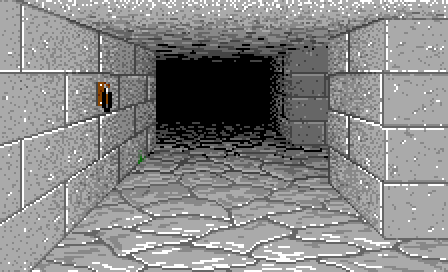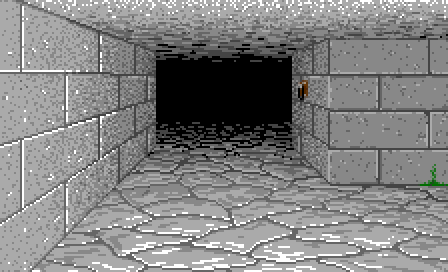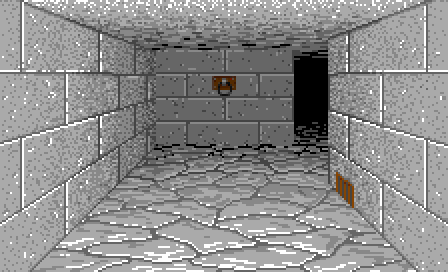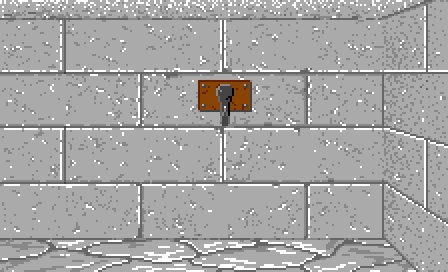Téléchargements
Exécutable de l'éditeur de niveaux - exactement le même que la partie 12 (Windows 32bits)
Exécutable du jeu (Windows 32bits)
Avant d'essayer de compiler le code, allez dans l'onglet "Projets" dans le menu de gauche, séléctionnez l'onglet "Run" pour votre kit,
et mettez dans "Working directory" le chemin de "editor\data" pour l'éditeur ou "game\data" pour le jeu.
Charger les bases de données
Le jeu a besoin d'avoir les informations qui sont dans "walls.xml" et "ornates.xml". Alors maintenant il les lit dans "walls.cpp".
Le code est assez similaire à l'éditeur, a part que nous lisons les noms images et les coordonnées qui sont dans "ornates.xml":
//--------------------------------------------------------------------------------------------------------
void CWalls::readOrnatesDB()
{
QDomDocument doc;
QFile f("databases/ornates.xml");
f.open(QIODevice::ReadOnly);
doc.setContent(&f);
f.close();
QDomElement root = doc.documentElement();
QDomElement ornate = root.firstChild().toElement();
while(!ornate.isNull())
{
if (ornate.tagName() == "ornate")
{
COrnateData newOrnate;
newOrnate.name = ornate.attribute("name");
QDomElement ornateInfo = ornate.firstChild().toElement();
while(!ornateInfo.isNull())
{
if (ornateInfo.tagName() == "image_front")
{
newOrnate.imageFront = QString("gfx/3DView/ornates/") + ornateInfo.text();
}
else if (ornateInfo.tagName() == "image_side")
{
newOrnate.imageSide = QString("gfx/3DView/ornates/") + ornateInfo.text();
}
else if (ornateInfo.tagName() == "pos_front")
{
newOrnate.posFront.x = ornateInfo.attribute("x").toInt();
newOrnate.posFront.y = ornateInfo.attribute("y").toInt();
}
else if (ornateInfo.tagName() == "pos_side")
{
newOrnate.posSide.x = ornateInfo.attribute("x").toInt();
newOrnate.posSide.y = ornateInfo.attribute("y").toInt();
}
ornateInfo = ornateInfo.nextSibling().toElement();
}
ornatesDatas.push_back(newOrnate);
}
ornate = ornate.nextSibling().toElement();
}
}
//---------------------------------------------------------------------------------------------
void CWalls::readWallsDB()
{
QDomDocument doc;
QFile f("databases/walls.xml");
f.open(QIODevice::ReadOnly);
doc.setContent(&f);
f.close();
QDomElement root = doc.documentElement();
QDomElement wall = root.firstChild().toElement();
while(!wall.isNull())
{
std::vector<CParamType> paramsTypesList;
if (wall.tagName() == "wall")
{
CWallData newWall;
newWall.name = wall.attribute("name");
QDomElement wallInfo = wall.firstChild().toElement();
while(!wallInfo.isNull())
{
if (wallInfo.tagName() == "param")
{
QString paramType = wallInfo.attribute("type");
if (paramType == "ornate")
{
CParamType newParamType;
newParamType.mType = eParamOrnate;
newParamType.mName = wallInfo.text();
paramsTypesList.push_back(newParamType);
}
}
wallInfo = wallInfo.nextSibling().toElement();
}
wallsDatas.push_back(newWall);
map.mWallsParams.push_back(paramsTypesList);
}
wall = wall.nextSibling().toElement();
}
}
Une autre table de murs
Les positions des décors seront calculées par rapport aux murs où ils apparaissent. Donc on a besoin d'une table avec
les positions et tailles des murs, pareille à la table que l'on a utilisée pour afficher les murs eux-mêmes:
// table avec les positions et tailles de chaque mur pour les décors
struct SWallInfos
{
CVec2 pos;
CVec2 size;
};
static const SWallInfos gWallsInfos[WALL_TABLE_HEIGHT][WALL_TABLE_WIDTH][3] =
{
// Rang 3 (le plus loin)
{
{{{0, 0}, {0, 0}}, {{0, 0}, {0, 0}}, {{0, 0}, {0, 0}} }, // 03
{{{0, 0}, {0, 0}}, {{ 8, 58}, {36, 48}}, {{0, 0}, {0, 0}} }, // 13
{{{0, 0}, {0, 0}}, {{78, 59}, {12, 48}}, {{134, 59}, {12, 48}}}, // 23
{{{0, 0}, {0, 0}}, {{0, 0}, {0, 0}}, {{180, 58}, {36, 48}}}, // 33
{{{0, 0}, {0, 0}}, {{0, 0}, {0, 0}}, {{0, 0}, {0, 0}} } // 43
},
// Rang 2
{
{{{-77, 58}, {70, 48}}, {{0, 0}, {0, 0}}, {{0, 0}, {0, 0}} }, // 02
{{{ 7, 58}, {70, 48}}, {{0, 0}, {0, 0}}, {{0, 0}, {0, 0}} }, // 12
{{{ 77, 58}, {70, 48}}, {{60, 52}, {18, 74}}, {{146, 52}, {18, 74}}}, // 22
{{{146, 58}, {70, 48}}, {{0, 0}, {0, 0}}, {{0, 0}, {0, 0}} }, // 32
{{{216, 58}, {70, 48}}, {{0, 0}, {0, 0}}, {{0, 0}, {0, 0}} } // 42
},
// Rang 1
{
{{{0, 0}, {0, 0}}, {{0, 0}, {0, 0}}, {{0, 0}, {0, 0}} }, // 01
{{{-46, 52}, {105, 74}}, {{0, 0}, {0, 0}}, {{0, 0}, {0, 0}} }, // 11
{{{ 59, 52}, {105, 74}}, {{33, 42}, {27, 111}}, {{164, 42}, {27, 111}}}, // 21
{{{164, 52}, {105, 74}}, {{0, 0}, {0, 0}}, {{0, 0}, {0, 0}} }, // 31
{{{0, 0}, {0, 0}}, {{0, 0}, {0, 0}}, {{0, 0}, {0, 0}} } // 41
},
// Rang 0 (le plus proche)
{
{{{0, 0}, {0, 0}}, {{0, 0}, {0, 0}}, {{0, 0}, {0, 0}}}, // 00
{{{-127, 42}, {159, 111}}, {{0, 0}, {0, 0}}, {{0, 0}, {0, 0}}}, // 10
{{{ 32, 42}, {159, 111}}, {{0, 0}, {0, 0}}, {{0, 0}, {0, 0}}}, // 20
{{{ 191, 42}, {159, 111}}, {{0, 0}, {0, 0}}, {{0, 0}, {0, 0}}}, // 30
{{{0, 0}, {0, 0}}, {{0, 0}, {0, 0}}, {{0, 0}, {0, 0}}} // 40
}
};
donne déjà leurs positions et les noms de fichiers qu'on peut utiliser pour connaitre leur taille.
Hé bien il y a plusieurs raisons à cela:
- D'abord dans la table, certaines cases sont vides même si on a une image pour ce mur. C'est parce que dans le
jeu, sur certains murs, les décors ne sont jamais affichés. Par exemple, dans le jeu d'origine, les décors n'apparaissent
jamais sur les murs qui sont juste à gauche et à droite de nous (Wall20_L et Wall20_R). On n'a même pas de graphismes pour
eux, car les graphs des décors de cotés sont pour les murs un rang plus loin (Wall21_L et Wall21_R). - Ensuite, certains murs n'apparaissent pas complètement. Pour les murs qui sont sur les bords de l'écran, comme Wall30_F
ou Wall31_F, les graphs n'en représentent qu'une partie. Mais on a besoin de connaitre la taille du mur complet pour bien
afficher les décors. - Enfin, j'ai du modifier un peu ces valeurs pour éviter que des décors "bougent" entre les différentes distances.
Parce que les graphs du jeu d'origine étaient loins d'être parfaits. Si vous essayez de calculer le ratio largeur/hauteur
pour les différents niveaux de murs de face, vous verrez ce que je veux dire.
Mise en place des variables
Après quelques tests pour savoir si on a un décor à afficher, on initialise les principales variables dont on aura besoin:
CWalls::COrnateData& ornateData = walls.ornatesDatas[ornate];
const SWallInfos* ornateTabData = &gWallsInfos[tablePos.y][tablePos.x][tableSide];
const SWallInfos* ornate0 = NULL;
QString ornateFileName;
CVec2 ornatePos;
bool ornateFlip = false;
switch(side)
{
case eWallSideUp:
ornate0 = &gWallsInfos[3][2][tableSide];
ornateFileName = ornateData.imageFront;
ornatePos = ornateData.posFront;
break;
case eWallSideLeft:
ornate0 = &gWallsInfos[2][2][1];
ornateFileName = walls.ornatesDatas[ornate].imageSide;
ornatePos = ornateData.posSide;
break;
case eWallSideRight:
ornate0 = &gWallsInfos[2][2][1];
ornateFileName = walls.ornatesDatas[ornate].imageSide;
ornatePos = ornateData.posSide;
ornateFlip = true;
break;
default:
break;
}
- ornateData pointe sur les données du fichier "ornates.xml".
- ornateTabData est la cellule du tableau où on veut afficher notre décor.
- ornate0 est la cellule du mur de référence - celle ou le décor à sa taille initiale devrait apparaitre.
Ca correspond au mur Wall20_F pour un décor de face ou au mur Wall20_L pour un décor de coté. Le retournement
pour le coté droit est géré plus tard. - ornateFileName contient le nom de fichier du graph de notre décor.
- ornatePos contiendra la position finale à l'écran.
- ornateFlip est un flag pour dire si le graph sera retourné. Il est seulement à true si notre décor est sur
un mur de droite.
Calculer la position et redimensionner l'image
// calcule la position et le facteur d'échelle et dessine le décor dans une image temporaire
float scale = (float)ornateTabData->size.y / 111.0f;
QImage ornateImage = fileCache.getImage(ornateFileName.toLocal8Bit().constData());
QSize ornateSize = ornateImage.size() * scale;
ornatePos = (ornatePos - ornate0->pos);
ornatePos.x = ornatePos.x * ornateTabData->size.x / ornate0->size.x;
ornatePos.y = ornatePos.y * ornateTabData->size.y / ornate0->size.y;
if (ornateFlip == true)
ornatePos.x = ornateTabData->size.x - ornatePos.x - ornateSize.width();
ornatePos += ornateTabData->pos;
QImage tempImage(ornateSize, QImage::Format_ARGB32);
tempImage.fill(QColor(0, 0, 0, 0));
graph2D.drawImageScaled(&tempImage, CVec2(), ornateImage, scale, ornateFlip);
Ensuite, on récupère la position du décor par rapport au mur de référence. Et on met à l'échelle cette position en fonction
du rapport entre les tailles du mur de destination et de celui de référence, à la fois en x et en y.
On aurait pu simplement multiplier cette position par le facteur d'échelle, mais j'ai constaté que c'était imprécis et que le
décor "bougeait" sur le mur.
Ensuite, il y a une correction si le décor est retourné, car on a calculé sa position par rapport à la gauche du mur, mais une
fois retourné ça devient une position par rapport à la droite.
Et enfin on ajoute cette position à celle du mur de destination, pour avoir la position du décor à l'écran.
Dans les 3 dernières lignes, on dessine le décor redimensionné dans une image temporaire. Je vais expliquer pourquoi tout de suite.
Assombrir l'image
Comme je l'ai dit dans la dernière partie, les décors apparaissent plus sombres quand ils sont plus loin de nous.
// assombrit le décor en fonction de sa distance
static const float shadowLevels[] = {0.0f, 0.2f, 0.4f};
float shadow;
if (side == eWallSideUp)
shadow = shadowLevels[WALL_TABLE_HEIGHT - 1 - tablePos.y];
else
shadow = shadowLevels[WALL_TABLE_HEIGHT - 2 - tablePos.y];
QPainter painter(&tempImage);
painter.setOpacity(shadow);
painter.setCompositionMode(QPainter::CompositionMode_SourceAtop);
painter.drawImage(QPoint(0, 0), *shadowImage);
painter.setCompositionMode(QPainter::CompositionMode_SourceOver);
painter.setOpacity(1.0f);
painter.end();
// dessine les décors à l'écran.
graph2D.drawImage(image, ornatePos, tempImage, 0, false, QRect(0, 33, MAINVIEW_WIDTH, MAINVIEW_HEIGHT));
C'est simplement une image remplie de noir initialisée auparavant.
Le mode de composition de Qt est choisi pour éviter d'assombrir les pixels transparents de notre décor.
Finalement on dessine notre décor à l'écran. Le dernier paramètre est un rectangle de "clipping" pour éviter de dessiner en
dehors de la vue 3D.
Un décor au milieu de la zone des armes ne serait pas beau.
De meilleurs graphismes
se contraindre à une palette de couleurs donnée et le résultat était parfois bizarre.
On n'est pas contraints à utiliser une palette fixe, et nos décors sont redimensionnés avec un filtrage bilinéraire, ce qui donne des
images qui sont plus proches de l'image à sa taille d'origine.
Regardez la différence sur les images ci-dessous. A gauche c'est des screenshots du jeu d'origine qui tourne sur un émulateur, et à
droite on a des screenshots de notre jeu:

Et voici encore quelques exemples:



